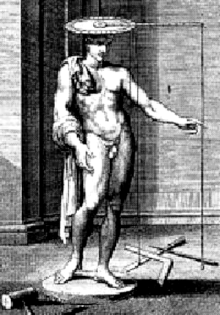
Back Màquina de treure punts Catalan Tečkovací strojek Czech Punktiergerät German Máquina de sacar puntos Spanish Pistesiirtolaite Finnish Pantographe des sculpteurs French Punteerapparaat Dutch





A pointing machine is a measuring tool used by stone sculptors and woodcarvers to accurately copy plaster, clay or wax sculpture models into wood or stone. In essence the device is a pointing needle that can be set to any position and then fixed. It further consists of brass or stainless steel rods and joints which can be placed into any position and then tightened. It is not actually a machine; its name is derived from the Italian macchinetta di punta. The invention of the tool has been ascribed to both the French sculptor and medallist Nicolas-Marie Gatteaux (1751–1832)[1][2][3] and to the British sculptor John Bacon[4] (1740–1799). It was later perfected by Canova.[5] However, similar devices were used in ancient times, when the copying of Greek sculptures for the Roman market was a large industry.
- ^ Cami Santamera: Sculpture In Stone, Barrons Educational Series Inc, 2001/10/01, ISBN 0-7641-5424-9
- ^ Biography of Gatteaux (French)
- ^ on Gatteaux' invention of the pointing machine (French)
- ^ Chisholm, Hugh, ed. (1911). . Encyclopædia Britannica (11th ed.). Cambridge University Press. which in turn cites Richard Cecil, Memoirs of John Bacon, R.A. (London, 1801) and J. Pratt, ed., R. Cecil's works, vol. i (1811)
- ^ Putman, Brenda, ‘’The Sculptor’s Way: A Guide to Modelling and Sculpture’’, Stone and Marble Carving by Robert A. Baillie, Farrar & Rinehart, Inc, New York, 1939, p. 305